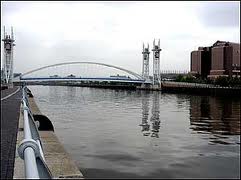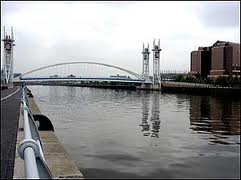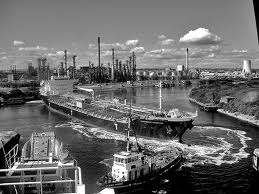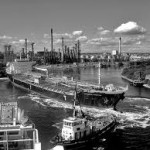Next tour: 17 July 2024, 1pm.
Meet: Entrance to the Science & Industry Museum, Lower Byrom Street.
Booking: Please press here to book for free with Eventbrite.
It’s the world’s greatest waterway, as deep as Suez, as wide as Panama, and it brought the sea into Manchester – almost as far as the city centre.
The Manchester Ship Canal was the last great man-made waterway to be constructed in Britain. A remarkable feat of Victorian engineering, linking the city with the Irish Sea at Liverpool, the canal resurrected the city’s dormant economy and enabled Manchester to become one of Britain’s biggest and busiest ports, despite being 35 miles inland.
The idea for such a canal had been discussed for years. Engineers had already tampered with the course of the local waterways. A company was formed in the 1820s to investigate the idea of this ship canal, but it was subjected to public ridicule and hostile songs were aired in local music halls. Parliament rejected the proposal while approving by one vote the building of a railway along the same route.
However the canal’s supporters weren’t dissuaded and their campaign gained ground in the 1870s when economic depression in Manchester saw industries fail, mills shut and workshops close. They knew they needed a way round the charges imposed by the Port of Liverpool for allowing cotton imports, charges that were so high it was cheaper for companies to bring their goods into England at Hull on the east coast and pay rail freight charges across the Pennines to reach Manchester.
The main drive for what became the Manchester Ship Canal came from engineer Daniel Adamson. He invited more than 70 local dignitaries – politicians and businessmen – to a meeting at his Didsbury home in June 1882 to “consider the practicability of constructing a tidal waterway toManchester”. Adamson told them: “If the Suez Canal, situated in a barbarous country and where for 50 miles there was a solid cutting of the depth of 26 feet, could be carried out there ought to be no engineering difficulties to stand in the way as far as theMerseyis concerned.”
The meeting decided to commission a detailed survey, but again the idea was ridiculed. “Real salt water could not come to Manchester,” claimed the Manchester Guardian,which wondered whether the city would turn into Amsterdam “with its smells”. More worried, understandably, was Liverpool where one newspaper commented: “Meddling with the river would be an act of felony”. The Bill received Royal Assent on 6 August 1885 which saw the Liverpool Post mock Manchester for planning to “throw £10,000,000 into a big ditch”.
Unperturbed, Manchester celebrated mightily. On Saturday 3 October 1885 around 30,000 people marched from Albert Square to Belle Vue Gardens excited at the prospect of more jobs, better wages and the imminent sight of steamships gliding along a canal only yards from the smokestack chimneys. So large was the triumphant throng that when the front section reached Belle Vue the back was just leaving Albert Square.
Work began on the canal in 1887 and lasted six years. Seventeen thousand navvies were taken on. They were known only by their nick-names and paid once a month, usually in the nearest pub. They wore, as Terry Coleman noted, “moleskin trousers, double canvas shirts, velveteen square-tailed coats, hobnail boots, gaudy handkerchiefs and white felt hats with the brims turned up.”
The canal builders were hampered by problems with the terrain, particularly the boggy ground, bad weather and flooding. In November 1890 locomotives, rolling stock and workmen’s materials vanished in a deluge as six miles of the canal and its bridges were washed away. A year later a train of 23 wagons was sent through the wrong points and fell directly on top of a team of 20 navvies.
The canal opened to traffic on New Year’s Day 1894. Manchester was now a customs port.
The History of the Manchester Ship Canal
from Ed Glinert’s “The Manchester Compendium”
The canal era staged one grand last hurrah after the coming of the railways: the Manchester Ship Canal. A remarkable feat of Victorian engineering, linking the city with the Irish Sea at Liverpool, the Manchester Ship Canal resurrected the city’s dormant economy and enabled Manchester to become one of Britain’s biggest and busiest ports, despite being 35 miles inland.
The idea for the canal had long germinated, and engineers had already tampered with the course of the local waterways. A company was formed in the 1820s to investigate the idea of a ship canal but it was subjected to public ridicule, and hostile songs were even aired in local music halls. Parliament rejected the proposal while approving by one vote the building of a railway along the same route. However the canal’s supporters weren’t dissuaded, and their campaign gained ground in the 1870s when economic depression in Manchester saw industries fail, mills shut and workshops close. They knew they needed a way round the charges imposed by the Port of Liverpool for allowing cotton imports, charges that were so high it was cheaper for companies to bring their goods into England at Hull on the east coast and pay rail freight charges across the Pennines to reach Manchester.
The main drive for what became the Manchester Ship Canal came from engineer Daniel Adamson. He invited more than 70 local dignitaries – politicians and businessmen – to a meeting at his Didsbury home in June 1882 to “consider the practicability of constructing a tidal waterway to Manchester”. Adamson told them: “If the Suez Canal, situated in a barbarous country and where for 50 miles there was a solid cutting of the depth of 26 feet, could be carried out there ought to be no engineering difficulties to stand in the way as far as the Mersey is concerned.”
The meeting decided to commission a detailed survey, but again the idea was ridiculed. “Real salt water could not come to Manchester,” claimed the Manchester Guardian,which wondered whether the city would turn into Amsterdam “with its smells”. More worried, understandably, was Liverpool where one newspaper commented: “Meddling with the river would be an act of felony”. The Bill received Royal Assent on 6 August 1885 which saw the Liverpool Post mock Manchester for planning to “throw £10,000,000 into a big ditch”.
 Unperturbed, Manchester celebrated mightily. On Saturday 3 October 1885 around 30,000 people marched from Albert Square to Belle Vue Gardens, excited at the prospect of more jobs, better wages and the imminent sight of steamships gliding along a canal only yards from the smokestack chimneys. So large was the triumphant throng that when the front section reached Belle Vue the back was just leaving Albert Square. One visitor to the city that day who arrived knowing nothing of the festivities taking place around him was the Africa explorer Henry Morton Stanley. Alighting from his train he thought revolution had broken out.
Unperturbed, Manchester celebrated mightily. On Saturday 3 October 1885 around 30,000 people marched from Albert Square to Belle Vue Gardens, excited at the prospect of more jobs, better wages and the imminent sight of steamships gliding along a canal only yards from the smokestack chimneys. So large was the triumphant throng that when the front section reached Belle Vue the back was just leaving Albert Square. One visitor to the city that day who arrived knowing nothing of the festivities taking place around him was the Africa explorer Henry Morton Stanley. Alighting from his train he thought revolution had broken out.
Work began on the canal in 1887 and lasted six years. Seventeen thousand navvies were taken on. They were known only by their nick-names and paid once a month, usually in the nearest pub. They wore, as Terry Coleman noted, “moleskin trousers, double canvas shirts, velveteen square-tailed coats, hobnail boots, gaudy handkerchiefs and white felt hats with the brims turned up.”
The canal builders were hampered by problems with the terrain, particularly the boggy ground, bad weather and flooding. In November 1890 locomotives, rolling stock and workmen’s materials vanished in a deluge as six miles of the canal and its bridges were washed away. A year later a train of 23 wagons was sent through the wrong points and fell directly on top of a team of 20 navvies.
The canal opened to traffic on New Year’s Day 1894. Manchester was now a customs port. But Daniel Adamson, who had done so much to catalyse the project, was not around to see it. He had died in January 1890. So too had Thomas Walker, the main contractor, which caused a loss of confidence in the company and the withdrawal of some financial backers. The company was rescued by the Manchester Corporation which took over 51% of the Ship Canal Company shares.
The opening of the canal buoyed a number of local industries such as flour milling and paper making. It was soon carrying imports such as timber, grain, meat, fruit, sugar and oil, whose importance wasn’t realised at first. In its first year the canal handled nearly one million tons of cargo, but it wasn’t a financial success until the 20th century. Many ship owners continued to use the established ports, and rumours that the new canal wouldn’t be able to handle large vessels meant traffic remained low. A lead was taken by North-East firms, who used the canal for importing raw cotton. This, and the exporting of finished cotton goods, buoyed the company.
By 1903, Manchester was the fourth largest port in the country. It was no longer reliant on the cotton industry for its economic strength for the canal had brought new and different industries – cars, food, paper – to Manchester, particularly at Trafford Park. It continued to prosper until the 1950s when the importing of cheaper foreign textiles, made, ironically, on machines produced in Manchester, brought misery to the local textile industry and led to a decline in the use of the canal. The following decade saw the introduction of containerisation – the packing of goods into huge containers which were unloaded from the ferries nearer the sea – which made the Manchester docks and much of the Ship Canal redundant.
When the Ship Canal Company began contemplating closing the upper reaches a private company, Peel Holdings, stepped in and assiduously bought the shares. On gaining control, it turned the Manchester Ship Canal Company into property developers and began to regenerate the now derelict ex-industrial land on its banks.
The 21st century Ship Canal is symbolised not by ocean-going liners, bringing the world’s produce to the city on its waterway, but by giant corporate projects located along the water’s edge – the Trafford Centre shopping mall, the Lowry Centre arts complex, the Imperial War Museum North, and most of all the corporate skyscrapers of Salford Quays. The lower reaches of the canal are still busy with shipping, particularly around the Queen Elizabeth II Dock at Eastham and the Stanlow Oil Refinery, carrying some seven million tonnes of cargo, mostly oil, chemicals and grain, and the sighting of a cargo ship in the old Manchester Docks area is now a rarity.
Manchester Ship Canal – Facts and Figures
• The 35½ mile long canal begins at the sea end by Eastham, Cheshire, where the company chairman, Lord Egerton, cut the first sod on 11 November 1886, the earth ceremoniously wheeled away in a silver barrow.
• The course of the waterway mostly follows that of the adjacent River Mersey, west of the confluence with the River Irwell, after which it merges with the latter river. The canal officially ends a mile west of city centre Manchester by Hulme Hall Road/Woden Street.
• There were 39,000 shareholders when the Manchester Ship Canal company was formed, the largest number any company had ever gathered at that time.
• The cheque with which the company bought the navigation rights in 1886 was then the largest ever signed at £1.7 million.
• The depth of the canal is 26 feet, the same as the Suez Canal, and four times that of the Irwell.
• There are five sets of locks: at Eastham, Latchford, Irlam, Barton and Mode Wheel.
• Stanlow Oil Refinery at the western end of the canal, where the smell of petrol hangs in the air, was built in 1922 on the site of a Cistercian monastery riddled with underground passages only discovered during construction of the canal.
• Passenger ships plied the canal in its early days but they had stopped by 1896 as by then there was no room for non-industrial activity.




